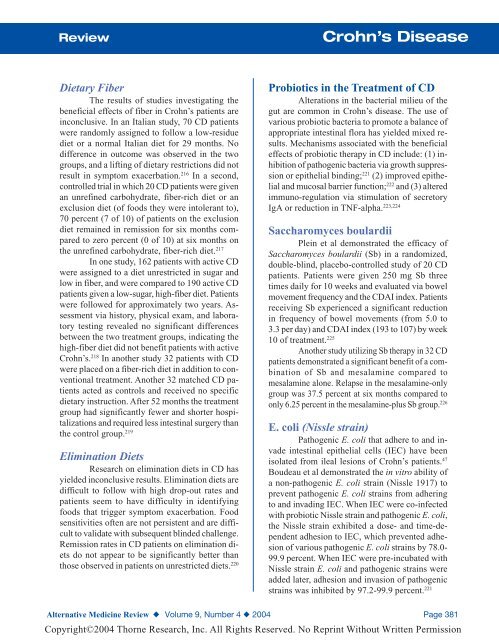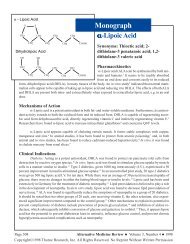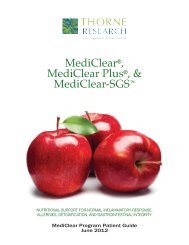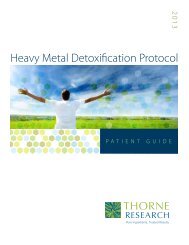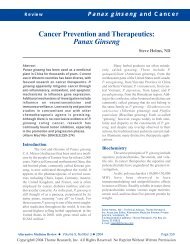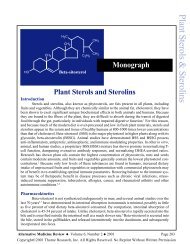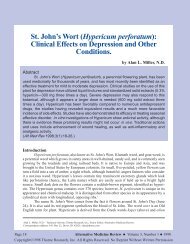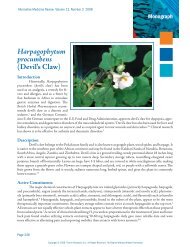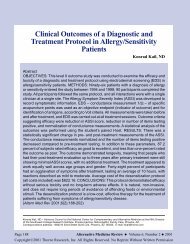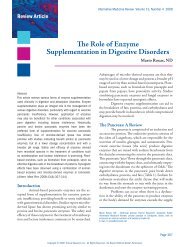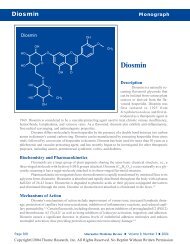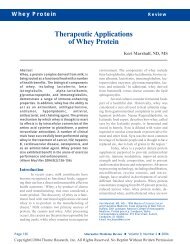Crohn's Disease - Thorne Research
Crohn's Disease - Thorne Research
Crohn's Disease - Thorne Research
You also want an ePaper? Increase the reach of your titles
YUMPU automatically turns print PDFs into web optimized ePapers that Google loves.
ReviewCrohn’s <strong>Disease</strong>Dietary FiberThe results of studies investigating thebeneficial effects of fiber in Crohn’s patients areinconclusive. In an Italian study, 70 CD patientswere randomly assigned to follow a low-residuediet or a normal Italian diet for 29 months. Nodifference in outcome was observed in the twogroups, and a lifting of dietary restrictions did notresult in symptom exacerbation. 216 In a second,controlled trial in which 20 CD patients were givenan unrefined carbohydrate, fiber-rich diet or anexclusion diet (of foods they were intolerant to),70 percent (7 of 10) of patients on the exclusiondiet remained in remission for six months comparedto zero percent (0 of 10) at six months onthe unrefined carbohydrate, fiber-rich diet. 217In one study, 162 patients with active CDwere assigned to a diet unrestricted in sugar andlow in fiber, and were compared to 190 active CDpatients given a low-sugar, high-fiber diet. Patientswere followed for approximately two years. Assessmentvia history, physical exam, and laboratorytesting revealed no significant differencesbetween the two treatment groups, indicating thehigh-fiber diet did not benefit patients with activeCrohn’s. 218 In another study 32 patients with CDwere placed on a fiber-rich diet in addition to conventionaltreatment. Another 32 matched CD patientsacted as controls and received no specificdietary instruction. After 52 months the treatmentgroup had significantly fewer and shorter hospitalizationsand required less intestinal surgery thanthe control group. 219Elimination Diets<strong>Research</strong> on elimination diets in CD hasyielded inconclusive results. Elimination diets aredifficult to follow with high drop-out rates andpatients seem to have difficulty in identifyingfoods that trigger symptom exacerbation. Foodsensitivities often are not persistent and are difficultto validate with subsequent blinded challenge.Remission rates in CD patients on elimination dietsdo not appear to be significantly better thanthose observed in patients on unrestricted diets. 220Probiotics in the Treatment of CDAlterations in the bacterial milieu of thegut are common in Crohn’s disease. The use ofvarious probiotic bacteria to promote a balance ofappropriate intestinal flora has yielded mixed results.Mechanisms associated with the beneficialeffects of probiotic therapy in CD include: (1) inhibitionof pathogenic bacteria via growth suppressionor epithelial binding; 221 (2) improved epithelialand mucosal barrier function; 222 and (3) alteredimmuno-regulation via stimulation of secretoryIgA or reduction in TNF-alpha. 223,224Saccharomyces boulardiiPlein et al demonstrated the efficacy ofSaccharomyces boulardii (Sb) in a randomized,double-blind, placebo-controlled study of 20 CDpatients. Patients were given 250 mg Sb threetimes daily for 10 weeks and evaluated via bowelmovement frequency and the CDAI index. Patientsreceiving Sb experienced a significant reductionin frequency of bowel movements (from 5.0 to3.3 per day) and CDAI index (193 to 107) by week10 of treatment. 225Another study utilizing Sb therapy in 32 CDpatients demonstrated a significant benefit of a combinationof Sb and mesalamine compared tomesalamine alone. Relapse in the mesalamine-onlygroup was 37.5 percent at six months compared toonly 6.25 percent in the mesalamine-plus Sb group. 226E. coli (Nissle strain)Pathogenic E. coli that adhere to and invadeintestinal epithelial cells (IEC) have beenisolated from ileal lesions of Crohn’s patients. 47Boudeau et al demonstrated the in vitro ability ofa non-pathogenic E. coli strain (Nissle 1917) toprevent pathogenic E. coli strains from adheringto and invading IEC. When IEC were co-infectedwith probiotic Nissle strain and pathogenic E. coli,the Nissle strain exhibited a dose- and time-dependentadhesion to IEC, which prevented adhesionof various pathogenic E. coli strains by 78.0-99.9 percent. When IEC were pre-incubated withNissle strain E. coli and pathogenic strains wereadded later, adhesion and invasion of pathogenicstrains was inhibited by 97.2-99.9 percent. 221Alternative Medicine Review ◆ Volume 9, Number 4 ◆ 2004 Page 381Copyright©2004 <strong>Thorne</strong> <strong>Research</strong>, Inc. All Rights Reserved. No Reprint Without Written Permission


